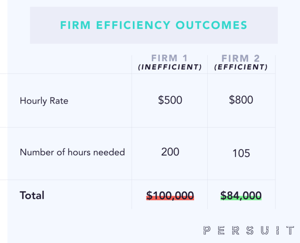
So you have your panel of preferred firms, it’s a new billing period and you’re negotiating legal rates. You may run into a few problems when negotiating rates (listed here), but there are certainly a couple solutions that will alleviate the bulk of your woes (also listed here - how convenient!).
First, one needs to understand the 3 inputs in a firm’s cost equation during legal rate negotiation:
- Hourly Rate
- Efficiency (i.e., hours billed)
- Staffing Leverage (i.e., delegation of work to more junior resources)
These inputs result in a firm’s cost output (i.e., the total fees to be paid by the client) and are crucial considerations during negotiation.
The Problem for Clients in Negotiating Rates:
Bargaining Power
The amount of bargaining power a client has at the point of negotiation is critical to success in negotiating lower rates. Clients are in a worse bargaining position when negotiating rates on an annual basis, rather than the point of selection for a piece of work (or ‘matter’/deal). Why? On an annual basis, firms have already been assigned work on existing matters; and firms are aware that clients are not going to remove them from current matters just because that firm has raised its rates. A firm has more freedom to raise its rates despite a new annual period, since matters often extend beyond a single period. This results in low client bargaining power. In contrast, negotiating prior to making a new selection decision for a specific matter offers the client increased bargaining power, since firms have the opportunity to be assigned new projects and open new revenue streams.
Efficiency Evaluation and Staffing Leverage
2a) Efficiency refers to the number of hours needed to complete an activity. An inefficient firm might have a relatively low hourly rate but require more hours to complete an activity, which could lead to a higher total price than a firm with a higher hourly rate and a lower number of hours needed to complete an activity. Sometimes a firm that appears more expensive and/or “premium” might actually offer a better bargain, since they might be efficient with hours (a quality that requires skill in work delegation or “staffing leverage” - see below - and access to certain legal technology). Clients should consider hours required when negotiating legal rates.

(Note that a low hourly rate is just one part of the efficiency equation [hourly rate x hours required], and it cannot be judged alone.)
2b) Staffing leverage is related to efficiency. (What is staffing leverage? It is what happens when work is successfully delegated to respective levels of staff depending on what is most beneficial to both the firm and client.) Some law firms do a better job of delegating tasks from partners to associates where appropriate, and this drastically lowers the total cost of the service for the client. Again, efficiency combined with staffing leverage results in a lower total rate; so consider these factors along with the hourly rate.
2c) Information on efficiency and staffing leverage might not be readily available to the client, which poses a problem during negotiation. Clients should calculate the weighted average hourly rate (which will take both efficiency and staffing leverage into account properly) across the firm and compare that to the firm’s peers to determine the appropriateness of any requested rate increase.
The Data Problem
A client may find that there isn’t enough relevant historical data regarding legal pricing for the client’s particular needs - and thus what a client should pay for these needs. Benchmarking resources are out there, but they might (1) come at a significant price, and/or (2) vary with a certain e-billing system and/or (3) not be as granular as needed (e.g., accounting for practice area, city, etc.). Since the data is often incomplete and/or not publicly available to all parties, conflicts may arise between parties who have formed their own expectations based on their own data.
There is an additional data problem: historical data itself may be out of date, relative to how current demand has changed. (We’re in the middle of a national pandemic, so demand has decreased, affecting rates. A firm probably would not price similar to what they priced in 2018.)
Time Consuming
As a client looking for the best legal rate(s), you want the most information possible. In an ideal world, you should be able to negotiate with hundreds of firms in order to secure the best financial outcome for the company. But that’s often not a realistic ask, since it would take incredibly long to come to terms with each firm over respective details every year. (It could take half of the year just to settle what your rates are going to be!)
And one might reason that a low rate might justify a longer time-spend, but it’s not worth the time considering that low efficiency (i.e., more hours billed to the client) and low-leveraged staff (i.e., more cost dedicated for otherwise low-cost work) negate the benefits of a low hourly rate. A client must find a time-efficient way to consider all cost inputs and find an ideal firm.
The Solution for the Best Negotiated Legal Rates?
The solution to this problem is plainly: automated competition. Legal operations, RFP and bidding platforms (ahem, like PERSUIT) help clients obtain bargaining power, discover efficiency and leverage, solve the data problem and save time.
How? Here are a couple of options.
Option 1: Construct an Hourly Rate Auto-Negotiation Period Visible to Competing Firms
- Competition equates to bargaining power: Allow firms to see their hourly rates ranked along those of other firms in the same practice area. Firms are incentivized to put their best foot forward and give their most competitive rates, giving the bargaining power back to the client.
- The Auto-Negotiation Period solves time consumption, eliminates data concerns and keeps efficiency in mind: Provide firms a set period of time to revise rates to be more competitive. During this time, each firm must compete fairly, despite potentially varied historical data. Once the period has ceased, secure rates with a firm and proceed with the understanding that rates could impact selection later. The set period solves the time consumption issue; the mass participation in one competition solves the data issue; and the securement of a firm according to rates but contingent upon success keeps efficiency in mind.
Option 2: Create a Matter-by-Matter Bidding Process to Eliminate Obscurity
- Eliminate bargaining power issues further: With matter-by-matter bidding, you can obtain total cost proposals at the matter level, when firms are most incentivized to provide an attractive proposal. Why compare just 1 input (hourly rates) in the cost formula when you can look at the total cost? This option often utilizes AFAs, which allows the client to begin to pay for outcome rather than effort while also providing total cost predictability. It also generates more savings.
- Eliminate the data issue through real-time bidding and keep efficiency in mind: Like Option 1, real time bidding for matters utilizes a negotiation period, which negates historical data issues since all firms are competing despite differing data. The client obtains the true market price at a given point in time. And like Option 1, efficiency is kept in mind, since the selected firm is selected on the premise of success and low total rate consistency.
- Eliminate the time issue: Technology makes matter level bidding an easier proposition considering that it takes far less time than manual RFPs (Across all PERSUIT clients it takes 14min on average time to draft and send an RFP). This means lawyers can bid out every matter that comes in the door to obtain competitive fee arrangements more consistently.
Overall, Option 2 takes Option 1 to the next level (which we like).
Both of these options offer alternatives to the traditional rate negotiation process by providing a shorter, simpler ‘game:’ there are clear parameters, a fixed period of time and provisions that eliminate any asymmetry of information/data between parties -- each firm brings exactly what they have to the table. The new process creates a competition that results in clearer stipulations and lower prices - for the sake of winning a client. In other words, the problems above are eliminated.